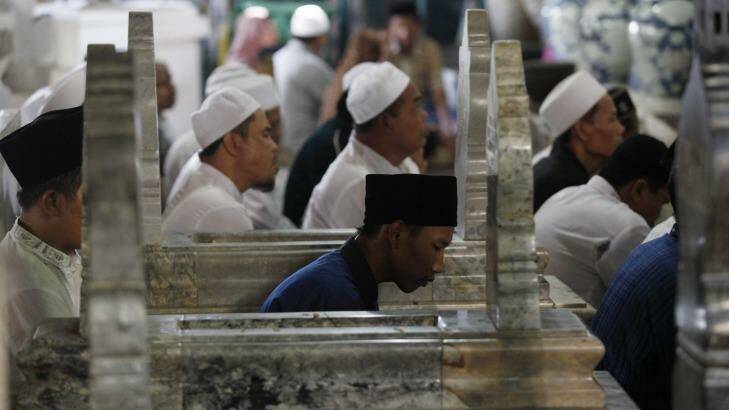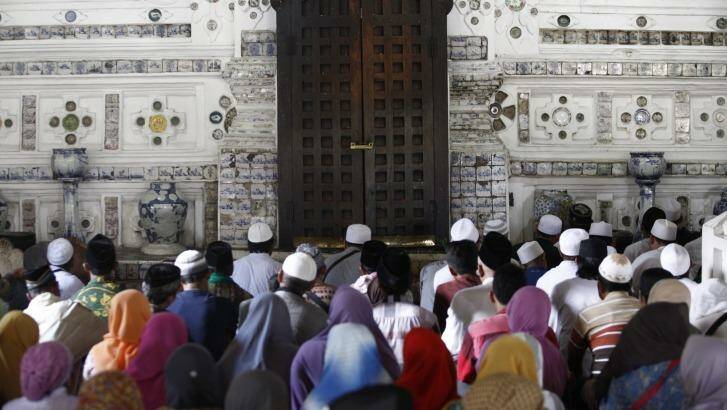








Subscribe now for unlimited access.
$0/
(min cost $0)
or signup to continue reading
Cirebon: It's hard to know for certain what a Muslim saint who was born in 1448 might have looked like, but for a reasonable price you can wear his portrait on a T-shirt.
Kiosks outside the pilgrimage site devoted to Sunan Gunungjati in Cirebon, West Java, do a brisk trade selling tourist apparel along with flower petals, fragrant incense and canisters to scoop holy water.
Inside his mausoleum is a riot of sound and colour. There are gravestones spray-painted silver, a dusty chandelier, models of blue shrimps - Cirebon's nickname is Prawn Town - and walls decorated with porcelain plates.
Pilgrims pray on raised platforms or animatedly chant La ilaha ila Allah (There is no god but Allah).
Sunan Gunungjati was one of the Wali Songo, or nine saints, credited with spreading Islam across Java in the 15th and 16th centuries. Pilgrims might visit his tomb to seek help finding a soulmate or with a financial problem, says Muhammad Jadul Maula, who runs an Islamic cultural school in Yogyakarta.
"They sometimes ask the Wali Songo to say a prayer to God about their problems. They believe Wali Songo are saints, close to God, and it is hoped their prayers will be answered," he says.
Sunan Gunungjati used wayang puppetry, a Hindu art form, to spread the word of Islam. This was typical of the Wali Songo, who embraced cultural practices from pre-existing faiths in their proselytising, including kapitayan, the ancient religion of Java.
This syncretism is part of what gives the Islam of Indonesia, known as Islam Nusantara, its unique flavour. It is also considered heresy by some Muslims, such as those who espouse the ultra-conservative brand of Sunni Islam known as Salafism or Wahhabism.
Wahhabists oppose the veneration of saints and pilgrimages to tombs, which they see as idolatry.
Saudi Arabia - where this puritanical brand of Islam originated and has official status - has even demolished the tombs of companions of the Prophet Muhammad in the holy cities of Mecca and Medina.
"Muslims are not allowed to idolise anyone," says Irfan Awwas, head of the executive board of the Wahhabi-inspired Indonesian Mujahideen Council. "(Pilgrims) pray to dead people. They idolise the Wali Songo."
The influence of Wahhabi teaching, funded by Saudi money, is spreading in Indonesia - six satellite TV stations promote its theology 24/7.
But if anything, pilgrimage to the Wali Songo shrines is more popular than ever, in part due to government promotion of the sites as tourist destinations.
"Visiting tombs is an old tradition in Indonesia, so it is difficult to attack this tradition," Jadul Maula says.
A couple of years ago a tomb was bombed in Yogyakarta, with the word kafir (infidel) scrawled across the tombstone.
"What is interesting is that people immediately realised it was a provocation," Jadul Maula says. "Now more people go to the tomb."
Many Indonesians believe the legacy of the Wali Songo is Islam Nusantara, a pluralistic, tolerant form of Islam that inspired the nation's founders to establish a multi-religious state in 1945.
This week the largest Islamic civil group in the world - Indonesia's Nahdlatul Ulama (NU) - will host a two-day international summit of Muslim leaders in Jakarta.
The summit, attended by 300 Muslim leaders from more than 30 countries, is part of NU's global campaign to promote Islam Nusantara as an antidote to extremist ideology and jihadism.
NU's Supreme Council general secretary, Yahya Cholil Staquf, believes the event will be historic because it will discuss frankly the links between terrorism and Islam.
Yahya, whose family has produced kiai (Islamic scholars) for generations, is shocked by the argument often presented in the West that Islam has nothing to do with extremism and terrorism.
He says provisions within fiqh (Islamic jurisprudence) allow for slavery and executions. It is from these medieval interpretations of Islam that the so-called Islamic State and al-Qaeda draw justification for their actions.
"If we may implement without questioning any provision of fiqh ... then we may ... butcher people according to the rules of fiqh that still exist today," Yahya says. "This is a problem."
NU is pushing for a debate about how literal interpretations of Islamic law - relevant at the time of the Prophet Muhammad - can be revised to reflect contemporary society.
There is a heightened urgency to this battle of ideas given that IS claimed responsibility for a terror attack in Central Jakarta in January which killed eight people. "We want to encourage people to acknowledge the problem honestly and stop denying it," Yahya says.
Hajriyanto Thohari, an executive board member of Muhammadiyah, Indonesia's second-largest Islamic civil organisation, believes this linkage of Islam and terrorism is simplistic.
Muhammadiyah promotes a "modernist" view of Islam, rejecting customary Indonesian rituals such as tahlilan, the prayers for the dead recited at deceased people's homes.
"The root of terrorism is injustice in politics and the economy," Hajriyanto says.
He argues that Malaysia is a state based on Islam, where the Koran is interpreted literally.
"Why is there no terrorism in Malaysia? Because the Malaysian government is successful in providing economic justice, it has a good political system where Islam is the official religion but non-Muslims can be in the government, the military etc."
Hajriyanto says Indonesia's founding fathers failed to offer a clear explanation to the country's Muslim community of their decision to adopt Pancasila, a state ideology of five founding principles. The first of these principles was monotheism, and Pancasila recognised six official religions - including Islam - in a secular democratic state.
"The majority of Indonesians see that it shows the great heart of Indonesian Muslims, it shows Indonesian Muslims' tolerance, but some small groups see it as the defeat of Islam," Hajriyanto says. "And these small groups are very noisy. They are the ones who are today voicing the need for a caliphate."
The idea of Islam possessing a distinct Indonesian identity provokes fierce debate. During celebrations to mark Isra and Miraj (the Prophet Muhammad's Night Journey to Jerusalem and then heaven) at the presidential palace last year, a university professor sparked controversy when he recited 15 verses of the Koran to a Javanese melody.
The Council of Indonesian Ulama (MUI), Indonesia's peak body of Islamic scholarship, denounced the recitation as "an embarrassment for Indonesia", saying the Koran was revealed in Arabic and had to be read according to that language's tradition.
But the recitation was defended by Religious Affairs Minister Lukman Hakim Saifuddin, who said it preserved Indonesia's traditions and spread the teaching of Islam through the country.
A month later the Islam Nusantara campaign received an enormous boost when President Joko Widodo, known as Jokowi, described it as a force to counter extremism.
Jokowi said leaders of other countries often expressed surprise that people in Indonesia - an overwhelmingly Muslim country with a population of 250 million - lived safely with mutual tolerance.
"Thanks be to God, our Islam is Islam Nusantara, which is full of respect, courtesy and tolerance," he added.
But conservative Islamic groups see Islam Nusantara as deviant and an attempt to localise Islam, which they argue is a universal faith with one God, one Koran and one messenger.
"Islam Nusantara is not Islam because [it] believes that it is different to Islam in [the] Arab [world]," says Awwas. "[Islamic State] are angry at the liberals such as Islam Nusantara for ignoring Islamic teachings. But the way they react is wrong because it shows their misunderstanding of Islamic teachings.
"Meanwhile Islam Nusantara is just the same, because they see other Muslims as terrorists. My conclusion is that both IS and Islam Nusantara are equally evil, because both of them are damaging the image of Islam."
Every Christmas, Ansor - the youth wing of NU - deploys its paramilitary unit to provide security outside churches. Its general chairman, Yaqut Cholil Qoumas, hopes it can inspire similar acts of interfaith co-operation on a global level.
"We are facing a situation in the world where it is becoming normal to regard people from other faiths as infidels," Yaqut says. "Witnessing this development, Ansor is extremely concerned."
At an event parallel to this week's NU summit, Ansor will issue a declaration calling for the "renovation" of Islamic jurisprudence that discriminates against non-Muslims.
"Ansor's global unity forum will highlight the fact that elements within classical Islamic law explicitly enjoin discrimination against certain classes of human beings on the basis of religion," says C. Holland Taylor from the LibForAll Foundation, a non-profit organisation fighting for tolerant Islam which he co-founded with former Indonesian president and NU leader Abdurrahman Wahid in 2003.
"Ansor will issue a call to ulama (Islamic scholars) to examine the problems humanity is facing and see how they are connected to Islamic law and teachings and how these might be reconceptualised."

